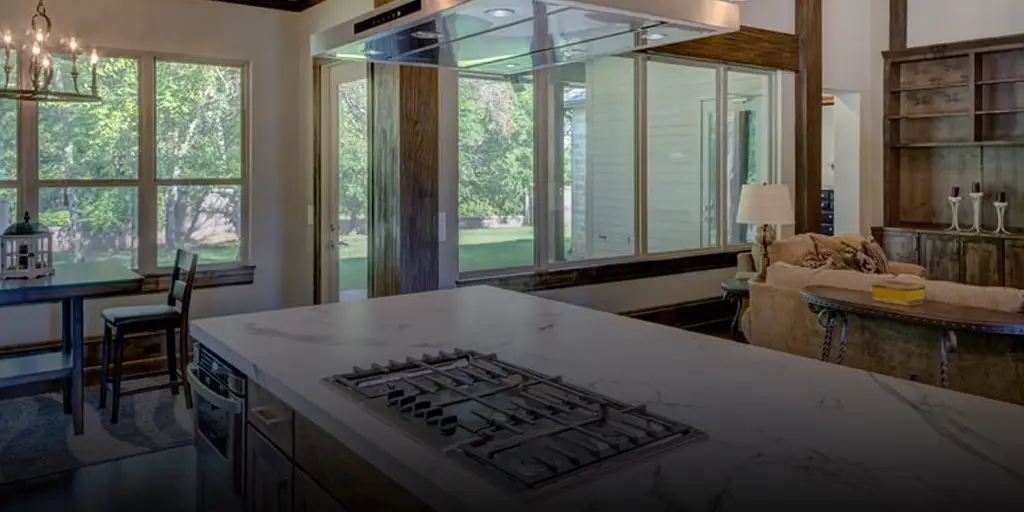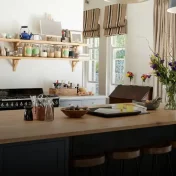The kitchen, often termed the heart of the home, is where culinary magic, casual family gatherings, and occasional reflections happen.
Amidst the aroma of freshly cooked meals and the subtle sound of utensils, the design of this space can notably impact its functionality and aesthetic appeal.

In the quest for that perfect blend of elegance and utility, the dilemma often arises – Kitchen Island or Peninsula?
In the diverse world of kitchen designs, kitchen islands and kitchen peninsulas stand as prominent features, each boasting distinct attributes, benefits, and aesthetic appeals.
These integral components are not just about expanding workspace; they embody style, storage, and the social dynamics of your kitchen.
Whether it’s the detached allure of kitchen islands or the connected grace of peninsulas, each brings a unique flavor to the table.
This comprehensive guide is an exploration of these two iconic elements, drawing a detailed comparison to offer insights, expert advice, and practical tips for homeowners embarking on the journey of kitchen remodeling.
We will dissect their structural nuances, weigh their benefits, evaluate cost implications, and provide real-life examples and case studies to offer a panoramic view of this Kitchen Island vs Peninsula narrative.
Ready to step into this world of refined elegance and informed choices? Let’s embark on this journey.
Key Points to Cover
- Exploration of kitchen islands and peninsulas
- Structural nuances and aesthetic attributes
- Expert advice and real-life examples
- Detailed comparison for informed decision-making
Basics of Kitchen Islands

Kitchen islands represent a freestanding piece of cabinetry, often centrally located and multifunctional, contributing both aesthetically and practically to the kitchen environment.
They are known for their versatility, offering additional workspace, storage, and often becoming a social hub in the kitchen.
Structure and Installation
Kitchen islands are characterized by their detached structure. They aren’t connected to the main counters or walls, offering a distinct, separate piece that becomes a focal point in the kitchen.
Installation requires securing the island to the floor, ensuring stability and safety. This detached nature allows for flexibility in design and placement, accommodating a range of kitchen sizes and layouts.
Materials and Design
From classic wood finishes to modern, sleek designs, kitchen islands can be customized in a myriad of materials and styles.
The countertop can be adorned with granite, quartz, marble, or other high-quality materials, each offering a distinct aesthetic and functional advantage.
Functionality
- Workspace: Offering additional counter space for food preparation.
- Storage: Incorporating cabinets and drawers to store utensils, cookware, and other items.
- Seating: Serving as a casual dining area or a space for social interactions.
- Appliance Housing: Can integrate appliances like dishwashers, ovens, or wine coolers.
Real-Life Example
Consider the story of Anna and John, who transformed their spacious kitchen by adding a majestic kitchen island.
Adorned with a marble countertop and equipped with a second sink and a dishwasher, it not only amplified the workspace but became the favorite gathering spot for family and guests.
The island, with its aesthetic allure and practical utility, elevated the entire kitchen’s ambiance.
Expert Quote
“A well-designed kitchen island can be a versatile centerpiece, offering an amalgamation of style, functionality, and social dynamics,”opines Jane Doe, a renowned interior designer.
Featured Attributes of Kitchen Islands
- Flexibility in Placement: Can be positioned as per the kitchen’s layout and user’s preference.
- Diverse Design Options: A plethora of materials and styles to choose from.
- Enhanced Functionality: Additional workspace, storage, and appliance integration.
- Social Hub: Becomes a gathering spot during parties or family time.
Exploring the world of kitchen islands unveils a landscape where elegance meets utility, offering homeowners the liberty to customize this space as per their functional needs and aesthetic preferences.
Basics of Kitchen Peninsulas

A kitchen peninsula stands as a connected extension, typically extending from the main countertop or wall, offering additional workspace, storage, and often seating.
It bridges the gap between isolated workspaces and open, accessible zones where interaction and functionality coexist.
Structure and Connection
Contrary to the isolated stance of kitchen islands, peninsulas are characterized by their connected structure. One end of the peninsula is adjoined to the main countertop or wall, offering an extension that feels integrated yet distinct.
This connectedness ensures efficient utilization of space, especially beneficial in smaller kitchens where every inch counts.
Materials and Continuity
Kitchen peninsulas often inherit the design aesthetics and materials of the existing counters, ensuring continuity in style.
Be it the sleek charm of quartz or the rugged elegance of granite; the peninsula becomes a seamless extension, both in function and form.
Functionality
- Extended Workspace: Amplifies the countertop area for varied kitchen tasks.
- Integrated Storage: Houses additional cabinets or shelves for optimized storage.
- Seating Option: Can serve as an additional dining or seating area.
- Utility Connections: Easier to connect utilities given its proximity to existing setups.
Case Study
Lucy’s compact kitchen was a blend of efficiency and charm. However, the need for additional workspace and storage was evident.
The introduction of a stylish kitchen peninsula, mirroring the aesthetics of her quartz countertops, not only offered the needed expansion but also introduced a cozy breakfast nook.
It exemplified how peninsulas can transform spaces, blending utility with allure.
Expert Insight
“The kitchen peninsula is a testament to adaptive design. It extends, adapts, and integrates, making it a favorite for those seeking a balance between space utilization and aesthetic harmony,” says interior expert,Mark Spencer.
Distinct Features of Kitchen Peninsulas
- Space Efficiency: Ideal for medium and small kitchens, optimizing available space.
- Design Continuity: Ensures a seamless aesthetic flow in the kitchen.
- Utility Access: Easier access to utilities due to its connected structure.
- Adaptive: Can be customized to serve as a workspace, storage, or seating area.
In the dynamic interplay of kitchen island vs peninsula, the latter emerges as a harmonious blend of space optimization and design continuity, especially revered in scenarios where space is at a premium yet the desire for style and functionality remains uncompromised.
Benefits of Kitchen Islands
Diving into the distinct world of kitchen islands, one is met with a plethora of benefits that cater to a variety of needs, ranging from enhanced functionality, aesthetic amplification to the creation of a social nucleus within the home.
Flexibility and Customization
Kitchen islands stand as a testament to flexibility. The detached nature of these pieces allows homeowners to tailor their placement, design, and functionality to fit precise needs and preferences.
- Design Diversity: Choose from an array of styles, materials, and finishes.
- Placement Liberty: Position the island to optimize flow and functionality.
- Functional Adaptability: Customize the island’s features to cater to specific needs.
Instant Social Space
A kitchen island naturally evolves into a social magnet. Its central positioning makes it an inviting spot for casual meals, conversations, and communal cooking experiences.
- Gathering Spot: Becomes the focal point during social gatherings.
- Casual Dining: Introduce bar stools for an instant casual dining spot.
- Interactive Cooking: Engages family and guests in the cooking process.
Enhanced Functionality
With an island, functionality takes a front seat. The additional countertop space, storage options, and the potential to house appliances make it a multifaceted addition.
- Extra Countertop: Ample space for food prep, serving, and more.
- Storage Solution: Integrated cabinets and drawers for organized storage.
- Appliance Integration: Hosts secondary sinks, dishwashers, ovens, etc.
Real-life Application
In Michael’s spacious kitchen, the addition of a robust wood-finish island not only amplified the workspace but introduced a dynamic social hub.
Equipped with a secondary sink, a wine cooler, and seating for four, it manifested as a blend of utility and sociability.
Expert Commentary
“Kitchen islands are not just about space and storage; they are living entities that breathe life, engagement, and warmth into a kitchen, making it a converging point of familial bonds,” reflects Emma Watson, a seasoned kitchen designer.
Key Benefits at a Glance
- Spatial Flexibility: Adapt to varied kitchen layouts and sizes.
- Aesthetic Versatility: A visual and functional centerpiece.
- Social Engagement: Fosters social interactions and communal experiences.
- Functional Expansion: Boosts storage, workspace, and appliance housing.
Navigating through the world of kitchen islands unveils an enriched experience where aesthetic aspirations and functional needs converge, offering a personalized touch to the modern kitchen.
You May Also Enjoy Reading: Is the Kitchen Island Dead? The Experts Opinions
Benefits of Kitchen Peninsulas
In the discourse of Kitchen Island vs Peninsula, the latter carves its niche, blending seamlessly into the existing architectural design while offering added functionality and an enhanced aesthetic appeal.
The peninsula stands as a hallmark of adaptive design, merging the best of both worlds – the continuity of the traditional countertop and the multifunctionality akin to islands.
Continuous Countertops
A kitchen peninsula offers continuity in design, elegantly extending the existing countertop to provide additional workspace without a break in design harmony.
- Seamless Design: Offers an uninterrupted flow in aesthetic design.
- Extended Workspace: Increases countertop area, enhancing functionality.
Better Workflow
Given its connected design, peninsulas enhance the kitchen’s workflow, making transitions between different work zones efficient and fluid.
- Efficient Transitions: Facilitates easy movement within work zones.
- Integrated Design: Enhances the utility without occupying additional floor space.
Easier Utility Placement
The peninsula’s adjacency to the main countertop or wall makes the placement of utilities simpler and more cost-effective.
- Utility Accessibility: Easier to connect to existing power, water, and drainage lines.
- Functional Integration: Allows for seamless addition of sinks or cooktops.
Case Illustration
Sarah’s mid-sized kitchen was elegantly transformed with the addition of a stylish peninsula. It extended her quartz countertop, providing additional workspace while also housing a wine rack and extra storage cabinets. The peninsula also doubled up as a breakfast nook, illustrating its multifaceted utility.
Expert Voice
“The kitchen peninsula is the unsung hero in modular kitchen design. It embodies adaptability, offering a multifunctional space that integrates storage, workspace, and dining within a cohesive design narrative,” articulates Alex Thompson, a renowned kitchen architect.
Highlighted Benefits of Kitchen Peninsulas
- Space Optimization: A boon for smaller kitchens, maximizing utility within limited space.
- Design Harmony: Ensures aesthetic and functional continuity.
- Cost Efficiency: Often more cost-effective due to reduced utility installation complexities.
- Multifunctional Appeal: Adapts to varied roles, from a prep zone to a dining area.
The kitchen peninsula emerges as a versatile choice, particularly revered in space-constrained environments, delivering enhanced functionality without compromising the aesthetic integrity of the kitchen landscape.
Key Differences

In the intricate dance between Kitchen Island and Peninsula, understanding their distinct features and the unique benefits each brings to the table is essential.
These elements, though sharing similarities in enhancing workspace and storage, have inherent characteristics that define their individual essence.
Space and Layout Adaptability
Kitchen Islands:
- Stand alone, offering flexibility in placement and design customization.
- Ideal for spacious kitchens where additional floor space is available.
- Promote an open layout enhancing the room’s airy feel.
Kitchen Peninsulas:
- Connected to existing counters or walls, optimizing space usage.
- Suitable for smaller kitchens where space is a premium.
- Enhance workflow due to their integrated design.
Storage Accessibility
Kitchen Islands:
- Offereasy access to storage from all sides.
- No corner cabinets, reducing the occurrence of hard-to-reach areas.
Kitchen Peninsulas:
- Storage access is slightly limited due to the connected design.
- May have corner cabinets that can create ‘dead’ spaces.
Installation and Utility Connection
Kitchen Islands:
- Requires more intricate installation due to the standalone nature.
- Utility connections can be more complex and potentially expensive.
Kitchen Peninsulas:
- Easier and often cheaper to install utilities because of proximity to existing connections.
- Installation is generally more straightforward.
Case Study Comparison
Lisa’s kitchen island in her spacious home became a versatile centerpiece, equipped with a cooktop and a sleek breakfast bar.
In contrast, Tom’s peninsula, in his compact apartment, offered extra prep space and seamlessly extended the dining area without occupying additional floor space.
Both added value, but their suitability was influenced by the available space and specific needs.
Read Also: How Much Does a Kitchen Designer Cost?
Expert Contrast
“While islands offer a distinct, flexiblecharm, peninsulas counter with space efficiency and functional integration.
The choice boils down to the specific spatial and functional dynamics of each kitchen,” notes interior expert, Alan Smith.
Tabular Representation of Key Differences
| Feature | Kitchen Island | Kitchen Peninsula |
|---|---|---|
| Placement | Detached | Connected |
| Space Suitability | Spacious kitchens | Compact kitchens |
| Installation Complexity | Higher | Lower |
| Utility Connection | Potentially expensive | Generally cost-effective |
| Storage Accessibility | Easier access | Slightly limited |
These distinctions paint a vivid picture, enabling homeowners to evaluate their specific needs, spatial constraints, and aesthetic inclinations to make an informed choice in the Kitchen Island vs Peninsula debate.
Space Requirements
Navigating the terrain of kitchen island vs peninsula mandates a keen consideration of space — a critical element that influences functionality, movement, and the overall aesthetic appeal of the kitchen.
Each option, though distinct, requires strategic planning to optimize space utility while ensuring a harmonious, uncluttered ambiance.
Kitchen Island Space Considerations
A kitchen island necessitates ample space to justify its inclusion, ensuring it enhances functionality without impeding movement.
- Clearance Space: A minimum of 42 inches of space around the island is essential for comfortable movement and workflow.
- Work Aisle Width: Increasing the width to 48 inches is advisable if multiple people use the kitchen simultaneously.
Kitchen Peninsula Space Dynamics
Peninsulas, given their connected design, are often more forgiving in space requirements, making them a viable option for medium to small kitchens.
- Integration Space: Requires adequate space to ensure a seamless extension of the existing countertop or wall.
- Workflow Optimization: Should be strategically placed to enhance, not impede, the kitchen’s workflow.
Industry Insights: NKBA Guidelines
The National Kitchen and Bath Association (NKBA) provides insightful guidelines to optimize space utility while ensuring safety and comfort.
- Work Aisle Width: A minimum of 42 inches for one cook and 48 inches for multiple cooks.
- Walkway Width: Non-work aisle spaces should maintain a width of at least 36 inches.
The Kitchen Triangle Concept
A fundamental aspect of efficient kitchen design is the kitchen triangle — a concept that ensures easy and quick access between the sink, cooktop, and refrigerator.
- Leg Distance: Each leg of the triangle should not be less than 4 feet or more than 9 feet.
- Total Perimeter: The sum of all three legs should not exceed 26 feet to optimize movement.
Case Analysis
In Ella’s compact kitchen, a stylish peninsula, adhering to NKBA guidelines, ensured added functionality without compromising space utility.
In contrast, James’ expansive kitchen accommodated a large island, becoming a multifunctional centerpiece, thanks to the strategic adherence to space considerations.
Expert Insight
“Space planning is the cornerstone of effective kitchen design. Whether choosing an island or a peninsula, respecting spatial dynamics ensures a blend of aesthetic appeal and functional efficiency,” comments Rosa Kim, a celebrated kitchen planner.
Snapshot of Space Requirements
- Island: Demands generous space for movement and functionality.
- Peninsula: More adaptable to space constraints, offering flexibility.
- NKBA Guidelines: A crucial resource for optimizing space while ensuring comfort and safety.
- Kitchen Triangle: A vital concept ensuring efficient access between key work areas.
In the intricate dance of decision-making in the realm of kitchen island vs peninsula, a well-calibrated consideration of space can illuminate the path, ensuring choices that epitomize a blend of aesthetic allure and pragmatic functionality.
Cost Considerations

Embarking on the journey of adding a kitchen island or peninsula requires a keen evaluation of cost implications.
These include not just the initial installation costs but also the potential impacts on utility bills, maintenance, and the added value to your home.
Kitchen Island Cost Dynamics
Kitchen islands often demand a higher upfront investment. Their detached nature often entails extensive work, from installation to utility connections.
- Installation: Islands might require more intricate work in terms of installation and may necessitate floor modifications.
- Utility Connections: Establishing power, gas, and water lines can be complex and expensive.
Kitchen Peninsula Cost Insights
Peninsulas tend to be more cost-effective options due to their integrated nature, leading to savings in installation and utilitysetup.
- Integration Ease: Being attached to existing countertops or walls, installation is often straightforward.
- Utility Accessibility: Easier access to existing utility connections often results in lower setup costs.
Detailed Cost Breakdown
Here’s a detailed comparative evaluation to offer insights into the potential cost dynamics involved in both options.
| Cost Factor | Kitchen Island | Kitchen Peninsula |
|---|---|---|
| Installation | Often higher due to | Generally lower due to |
| standalone nature. | connected design. | |
| Utility Connections | Can be complex and | Easier and often more |
| potentially expensive. | cost-effective. | |
| Maintenance | May incur higher | Typically lower due to |
| maintenance costs. | simpler design. |
Real-World Scenario
In a real-life comparison, Megan’s choice of installing a kitchen island led to an increased budget due to the need for floor reinforcement and extensive electrical work.
In contrast, Alex’s peninsula installation was more budget-friendly, leveraging existing utility connections and structural integrations.
Expert Quote
“Balancing the aesthetic and functional aspirations with budgetary constraints is essential. Every kitchen is a unique ecosystem; understanding its spatial and functional dynamics can guide cost-effective and value-adding decisions,” says financial advisor, Jacob O’Connor.
Summarizing Cost Considerations
- Budget Analysis: A thorough examination of budget versus the desired features and installation complexities.
- Utility Costs: An evaluation of ongoing costs associated with utility connections and maintenance.
- Value Addition: Assessing how each option enhances the overall value of your home.
In the nuanced landscape of kitchen island vs peninsula, cost considerations illuminate the path, aiding homeowners in making informed decisions that encapsulate aesthetic desires, functional needs, and financial prudence.
Making the Choice

In the complex dance of decision-making between a kitchen island and peninsula, a confluence of factors converge — space, cost, functionality, and aesthetics.
Each kitchen, with its unique spatial dynamics, functional needs, and aesthetic aspirations, narrates a distinct story. Here’s a roadmap to guide this choice.
Space Utilization
Kitchen Islands:
- Consider if the kitchen has ample space to accommodate an island without impeding movement and workflow.
- Evaluate the island’s impact on the openness of the kitchen layout.
Kitchen Peninsulas:
- Assess if the kitchen layout can integrate a peninsula while enhancing functionality.
- Consider the peninsula’s role in dividing or connecting spaces within the home.
Functional Needs
Kitchen Islands:
- Ideal for kitchens needing additional workspace, storage, and a social hub.
- Assess the potential for integrating appliances and utilities.
Kitchen Peninsulas:
- Suitable for enhancing workspace and storage without occupying extra floor space.
- Evaluate the ease of connecting utilities and integrating with existing designs.
Aesthetic Aspirations
Kitchen Islands:
- Consider the island’s role as a centerpiece and its influence on the overall aesthetics.
- Evaluate customization options in materials, design, and features.
Kitchen Peninsulas:
- Assess how well the peninsula integrates with existing aesthetics.
- Consider the design options that ensure a seamless visual flow.
Budget and Value Addition
- Evaluate the Budget: Assess the budget against the installation, utility setup, and maintenance costs of both options.
- Value Addition: Consider how each option adds value to your home, enhancing its appeal and functionality.
Expert Consultation
Seek professional advice to marry your aspirations with the pragmatic aspects of installation, costs, and space optimization.
An expert can offer tailored insights, blending your desires with the specific dynamics of your kitchen.
Real-Life Example
Caroline, with a spacious kitchen and a generous budget, opted for a kitchen island, transforming her kitchen into a multifunctional space of elegance and utility.
Raj, with a compact kitchen, found his perfect ally in a peninsula, enhancing workspace and aesthetics within budget constraints.
Summarized Decision Matrix
- Spatial Dynamics: Evaluate the kitchen’s size and layout.
- Functional Needs: Assess the need for workspace, storage, and social spaces.
- Aesthetic Desires: Weigh the design aspirations and visual appeal.
- Budget Constraints: Balance the desires with financial prudence and value addition.
In the intricate narrative of kitchen island vs peninsula, each choice is profoundly personal, echoing the unique symphony of individual needs, space dynamics, and aesthetic inclinations.
It’s a journey of creating a space that is not just functional and beautiful but resonates with the intimate chords of homely warmth and personal touch.
Conclusion and Final Thoughts
The intricacies of choosing between a kitchen island and a peninsula are steeped in the nuanced evaluation of space, functionality, aesthetics, and budget.
Each option, bathed in its unique charm and practical utility, stands as a testament to the evolving narrative of modern kitchens — spaces where culinary arts, social interactions, and aesthetic expressions converge.
Reflecting on Key Insights
Kitchen Islands:
- A symbol of luxury, spaciousness, and multifunctionality, ideal for larger kitchens and open floor plans.
- A centerpiece that offers flexibility in design, placement, and utility integration.
Kitchen Peninsulas:
- A hallmark of space efficiency and integrated design, suitable for medium to small kitchens.
- A seamless extension that amplifies workspace and storage without compromising the aesthetic flow.
Integrating Personal and Practical Aspects
The journey to choose between these two icons of kitchen design is as personal as it is practical. It’s a dance between the tangible metrics of space and cost and the intangible allure of aesthetics and ambiance.
Expert Recommendations
Drawing insights from industry experts, the consensus leans towards a tailored approach. There isn’t a one-size-fits-all answer but a spectrum of possibilities, each echoing the unique dimensions, aspirations, and constraints of every homeowner.
“The choice between a kitchen island and peninsula is akin to crafting a piece of art. It’s about weaving together the threads of space, functionality, aesthetics, and budget to narrate a story — a story where every kitchen becomes a personalized sanctuary of culinary creativity and social engagements,” reflects renowned kitchen designer, Olivia Sterling.
Embarking on the Journey
As homeowners embark on this journey, armed with insights, guidelines, and expert opinions, the path unfolds.
It’s a path where every choice, every nuance, and every consideration is a step towardscreating a kitchen that isn’t just a space of culinary endeavors but a canvas where memories, experiences, and connections breathe life into the very essence of home.
Final Reflections
In the grand ballet of kitchen island vs peninsula, each stands as a testament to innovation, aesthetic grace, and functional elegance.
The choice isn’t about absolute rights or wrongs but about aligning with the intimate, personal, and practical aspects of homeowners’ lives.
It’s a narrative of transformation where every kitchen evolves into a living entity, echoing the warmth, functionality, and aesthetic aspirations of those who call it home.



